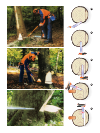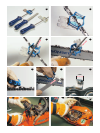
∞
1 2
Environmental regulations
Before felling any trees, find out which
environmental regulations apply and make
sure you have the necessary permits.
Prevent accidents
When you have decided to fell a tree,
you should think about what you can do
to prevent accidents. Take note of every-
thing that can affect safety. Are there any
roads, overhead lines or buildings nearby?
If so, and if you’re a beginner, you should
leave the job to someone with more
experience. If you know that people often
pass through the area, you should set
up warning signs.
Decide direction
Assess the tree and take note of various
factors that can affect the felling. Is the
tree leaning? Which way is the wind
blowing? Considering the surroundings
and ease of subsequent work, which
direction should it be felled in? (1)
Safe retreat
Clear obstructive undergrowth from
around the tree. Also, remove branches
and other obstacles on the ground. On
both sides of the tree, you should be able
to walk unobstructed at an angle away
from the falling tree, and remain there,
at a safe distance. (2)
Limbing, buttress roots
To work efficiently, you might need to
limb the lower part of the trunk. The
safest way to do this is with a pulling
chain, moving from above, downwards.
Use the trunk as protection between
you and the saw. Never limb higher than
shoulder height. (3)
Directional felling
The general idea of directional felling is
that you first saw a directional notch, which
determines which direction the tree will
fall. The directional notch can be made in
a variety of ways. The one we’re showing
here is called the open directional notch.
Stand by the tree and decide exactly
which direction you want to fell it in (4).
Choose some feature from the surroun-
dings as a guide (5). If the tree has buttress
roots, it’s a good idea to remove them (6).
First, you make a top cut into the stem,
at an angle of about 60 degrees. Saw to
a depth of about 20–25% of the tree’s
diameter. Then make a horizontal under
cut which meets the top cut. (7)
Hinge
Next you saw a horizontal felling cut
slightly above the level of the under cut.
It’s important that you stop sawing just
before you reach the directional notch,
leaving what is called a hinge. The
hinge guides the tree as it falls. Its width
should be 10% of the tree’s diameter
or at least two centimetres. (8)
Keepasafe distance
Make sure that there are no people
within the safety radius, which is at least
twice the length of the tree that you
plan to fell.
Felling trees.
Felling a tree is something that requires thought and planning. If you’re not experienced, you should
have someone with you who is. Work calmly and carefully.
Retreat 45°
Retreat 45°
Felling
direction


















